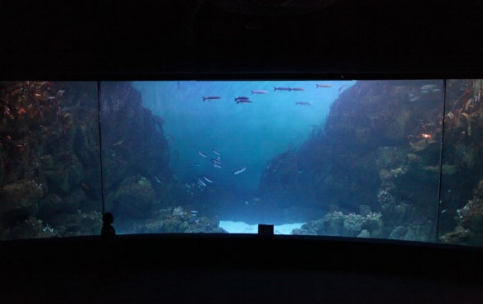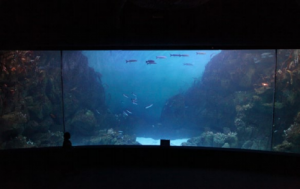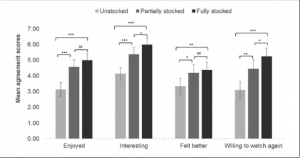Marine Biota and The Well Being of Humans
By Melissa Soto, SRC Intern
A small dose of nature can go a long way. Studies show that exposure to nature has a significant calming and stress reducing effect on humans. A recent study published in the United Kingdom examined how people’s behavior, physiological, and psychological reactions varied when exposed to an aquarium. The researchers recorded the participant’s reactions when the aquarium was unstocked (meaning no marine life), partially stocked (some marine life), and fully stocked (with plenty of marine life).
Previous research suggests that humans inherently want to be surrounded by nature. Taking place in the United Kingdom’s National Marine Aquarium, researchers wanted to see how much time people would spend in front of the large restocking exhibit along with any stress and emotional changes people experienced at the three stages of restocking.
There are three main ways to determine stress recovery with the assistance of nature. They are the Biophilia Hypothesis, the Psychophysiological Stress Recovery Theory (PSRT), and Attention Restoration Theory (ART). Biophilia is the emotional connection humans have with nature, PRST says humans are predisposed to react positively to nature, and ART suggests that mental irritability and distraction can be reduced with a nature setting. Although these three theories apply, ART is the one that worked best with this experiment as there are four parts. Fascination, being away, extent, and compatibility all resemble what people experienced as they view an aquarium. Here are the direct examples for these four components. 1. People were fascinated as they viewed the marine life 2. The everyday setting of their life was removed 3. They had the opportunity to be educated 4. They choose to visit the exhibit.
The scientists created three different hypotheses’ and explore them. The first was to see if voluntary exposure time would reflect intrinsic fascination and be positively correlated with the level of biota present within the exhibit. Second, there would be a positive relationship between psychophysiological responses and viewing the exhibit when it contained marine life. The final hypothesis was to see if longer exposure time to the exhibit would improve psychophysiological responses.
The participants entered the aquarium and stood in front of the exhibit when it was unstocked, partially stocked and fully stocked. Each participant stood alone while the aquarium transitioned into the different conditions. Measurements were taken twice weekly at different times of the day. Following this, the participant’s psychological mood was measured based on a “The Feeling Scale”. The scale showed whether the participants had a positive mood with high arousal, negative mood with high arousal, positive mood and low arousal or negative mood with low arousal.
Participants then made their way from the aquarium into a room where their blood pressure and heart rate was monitored. Blood pressure and heart rate monitoring was conducted for a total of five-minutes. Measurements were taken at the two-minute mark and at the five minute mark.
The results of this study showed that the participants stayed in front of the exhibit longest when it contained the highest level of marine life further supporting Hypothesis 1. The more biota allowed for more interest and willingness to watch. Hypothesis 2 and 3 were weaker but did show significant blood pressure and heart rate drops demonstrating that the exposure was calming and physiologically restorative.
Although this study was unsuccessful in determining a measurable effect on elevated stress, it did find new data to add to past studies. Overall, the participants left the aquarium feeling relaxed, in a positive mood, and slightly aroused. It also showed that an individual does not need to spend a long time in front of the exhibit, just five minutes, to gain significant benefits.
References
Cracknell, D., White, M., Pahl, S., Nichols, W., Depledge, M. (2015). Marine biota and psychological well-being: a preliminary examination of dose-response effects in an aquarium setting. Environment and Behavior, 1-28. doi: 10.1177/0013916515597512






Leave a Reply
Want to join the discussion?Feel free to contribute!